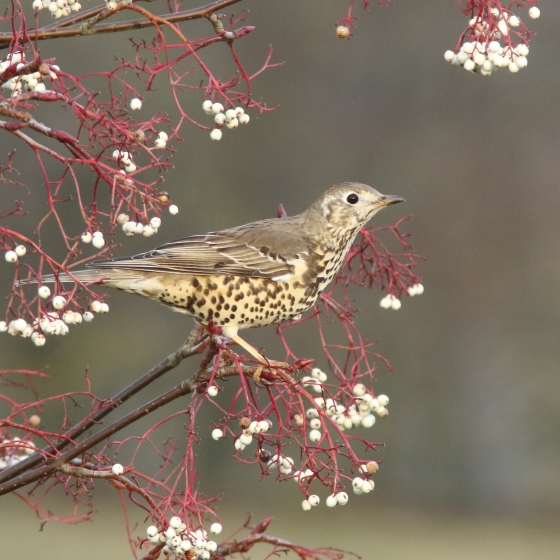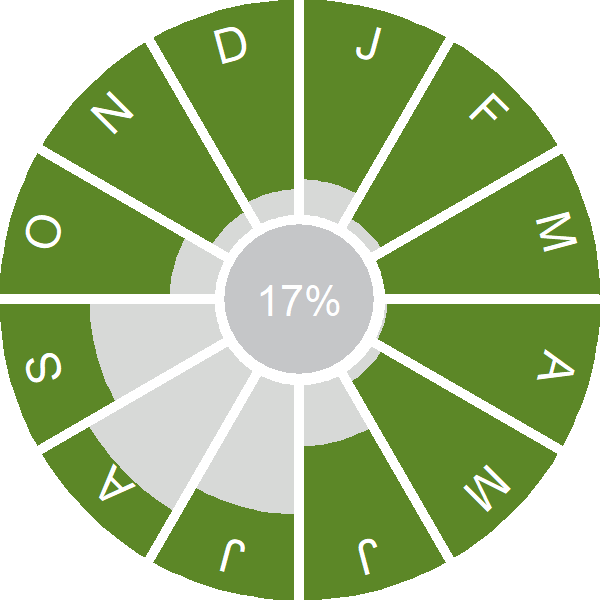Mistle Thrush

Introduction
The Mistle Thrush is the UK's largest thrush species.
The Mistle Thrush is a handsome bird with a brown back, greyish nape and crown and spotted breast and belly. Pairs may produce up to three clutches in a good year. The male has a wistful song which is often performed during or just after wet and windy weather, giving the species its folkname 'stormcock'.
The Mistle Thrush is found throughout Britain & Ireland expect for the Northern and Western Isles. Its population has undergone a decline in the UK since the late-1970s and the species has been on the UK Red List since 2015. The cause of this decline is not fully understood, but it might be linked to degradation of farmland habitat.
- Our Trends Explorer gives you the latest insight into how this species' population is changing.

Key Stats
Identification
ID Videos
This section features BTO training videos headlining this species, or featuring it as a potential confusion species.
#BirdSongBasics: Song Thrush and Mistle Thrush
Song Thrush and Mistle Thrush
Songs and Calls
Song:
Call:
Status and Trends
Conservation Status
Population Change
Like those of Song Thrush and Blackbird, Mistle Thrush populations have declined significantly since the mid 1970s. The species was moved from the green to the amber list of Birds of Conservation Concern in 2002 because of its UK population decline, and in the latest review it was added to the red list because its decrease had worsened (Eaton et al. 2015). The BBS map of change in relative density between 1994-96 and 2007-09 indicates that across Britain there is a steep gradient between decrease over that period in the southeast and increase in the northwest. Demographic data do not show any significant trends since 1967; population decline is thus likely to have been driven by reduced annual survival (Siriwardena et al. 1998b). The European trend has been broadly stable since 1980 (PECBMS: PECBMS 2020a>).
Distribution
Mistle Thrushes are widely distributed throughout Britain & Ireland, being found in 88% of 10-km squares in winter and 86% in the breeding season. They are absent from the Outer Hebrides and Northern Isles and from western parts of Co. Mayo. Some of these areas are occupied in winter by small numbers of immigrants. Otherwise, the only significant gaps are in the higher Scottish uplands. Densities are highest in Ireland. In Britain there are scattered pockets of high density, including some at moderate altitudes on the eastern fringe of the Highlands.
Occupied 10-km squares in UK
or view it on Bird Atlas Mapstore.
or view it on Bird Atlas Mapstore.
European Distribution Map
Distribution Change
Minor changes in winter and breeding range size belie marked regional trends in abundance, with decreases in abundance through much of England. These changes mirror a breeding population decline which has been under way since the 1970s.
Change in occupied 10-km squares in the UK
or view it on Bird Atlas Mapstore.
or view it on Bird Atlas Mapstore.
Seasonality
Mistle Thrush is widely recorded in winter, spring and summer but is hard to detect post breeding.
Weekly pattern of occurrence
The graph shows when the species is present in the UK, with taller bars indicating a higher likelihood of encountering the species in appropriate regions and habitats.

Movement
Britain & Ireland movement
Foreign locations of birds ringed or recovered in Britain & Ireland
Dots show the foreign destinations of birds ringed in Britain & Ireland, and the origins of birds ringed overseas that were subsequently recaptured, resighted or found dead in Britain & Ireland. Dot colours indicate the time of year that the species was present at the location.
- Winter (Nov-Feb)
- Spring (Mar-Apr)
- Summer (May-Jul)
- Autumn (Aug-Oct)

European movements
EuroBirdPortal uses birdwatcher's records, such as those logged in BirdTrack to map the flows of birds as they arrive and depart Europe. See maps for this species here.
The Eurasian-African Migration Atlas shows movements of individual birds ringed or recovered in Europe. See maps for this species here.
Biology
Productivity and Nesting
Nesting timing
Egg measurements
Clutch Size
Incubation
Fledging
Survival and Longevity
Survival is shown as the proportion of birds surviving from one year to the next and is derived from bird ringing data. It can also be used to estimate how long birds typically live.
View number ringed each year in the Online Ringing Report.
lifespan
Survival of adults
Survival of juveniles
Biometrics
Wing length and body weights are from live birds (source).
Wing length
Body weight
Ring Size
Classification, names and codes
Classification and Codes
- Order: Passeriformes
- Family: Turdidae
- Scientific name: Turdus viscivorus
- Authority: Linnaeus, 1758
- BTO 2-letter code: M.
- BTO 5-letter code: MISTH
- Euring code number: 12020
Alternate species names
- Catalan: griva comuna
- Czech: drozd brávník
- Danish: Misteldrossel
- Dutch: Grote Lijster
- Estonian: hoburästas
- Finnish: kulorastas
- French: Grive draine
- Gaelic: Smeòrach-mhòr
- German: Misteldrossel
- Hungarian: léprigó
- Icelandic: Mistilþröstur
- Irish: Liatráisc
- Italian: Tordela
- Latvian: sila strazds
- Lithuanian: amalinis strazdas
- Norwegian: Duetrost
- Polish: paszkot
- Portuguese: tordoveia
- Slovak: drozd trskota
- Slovenian: carar
- Spanish: Zorzal charlo
- Swedish: dubbeltrast
- Welsh: Brych Coed
- English folkname(s): Stormcock, Shrite
Research
Causes of Change and Solutions
Causes of change
Declines may be linked to reduced survival of juveniles. The paucity of information specific to Mistle Thrush represents a gap in knowledge that needs to be filled by new research.
Further information on causes of change
Similarities in population trends between Mistle Thrush, Song Thrush and Blackbird suggest a common cause of decline (Siriwardena et al. 1998a). As for Song Thrush (Robinson et al. 2004), Mistle Thrush decline may be linked to reduced survival of juveniles: both adult and juvenile survival was lower during periods of negative population trend than in stable or increasing ones (Siriwardena et al. 1998b). Demographic data do not suggest any close link between the population trend of Mistle Thrush and its breeding productivity, as there is no evidence of increased failure rates at egg or chick stage, or of reduction in fledglings per breeding attempt.
Mistle Thrush declines recorded by CBC were especially evident on farmland. Drainage of fields and removal of hedgerows would have reduced the habitat available for Mistle Thrush, as they did for Song Thrush (Chamberlain et al. 2000b, Peach et al. 2004).
Information about conservation actions
This species has been declining since the 1980s, but the main drivers of decline are not yet clear. Declines may be linked to reduced survival of juveniles and hence could be caused by similar reasons to the declines to its relatives, Blackbird and Song Thrush.
In the absence of specific research, therefore, similar actions to those proposed for Blackbird and Song Thrush may also benefit Mistle Thrush. These could include managing hedgerows or woodland habitat for wildlife (including management to provide good quality nesting cover in woodland), and policies to provide grazed grassland within arable landscapes and damper soils in summer.

